3.4: Sex linkage review
- Page ID
- 73542
\( \newcommand{\vecs}[1]{\overset { \scriptstyle \rightharpoonup} {\mathbf{#1}} } \)
\( \newcommand{\vecd}[1]{\overset{-\!-\!\rightharpoonup}{\vphantom{a}\smash {#1}}} \)
\( \newcommand{\dsum}{\displaystyle\sum\limits} \)
\( \newcommand{\dint}{\displaystyle\int\limits} \)
\( \newcommand{\dlim}{\displaystyle\lim\limits} \)
\( \newcommand{\id}{\mathrm{id}}\) \( \newcommand{\Span}{\mathrm{span}}\)
( \newcommand{\kernel}{\mathrm{null}\,}\) \( \newcommand{\range}{\mathrm{range}\,}\)
\( \newcommand{\RealPart}{\mathrm{Re}}\) \( \newcommand{\ImaginaryPart}{\mathrm{Im}}\)
\( \newcommand{\Argument}{\mathrm{Arg}}\) \( \newcommand{\norm}[1]{\| #1 \|}\)
\( \newcommand{\inner}[2]{\langle #1, #2 \rangle}\)
\( \newcommand{\Span}{\mathrm{span}}\)
\( \newcommand{\id}{\mathrm{id}}\)
\( \newcommand{\Span}{\mathrm{span}}\)
\( \newcommand{\kernel}{\mathrm{null}\,}\)
\( \newcommand{\range}{\mathrm{range}\,}\)
\( \newcommand{\RealPart}{\mathrm{Re}}\)
\( \newcommand{\ImaginaryPart}{\mathrm{Im}}\)
\( \newcommand{\Argument}{\mathrm{Arg}}\)
\( \newcommand{\norm}[1]{\| #1 \|}\)
\( \newcommand{\inner}[2]{\langle #1, #2 \rangle}\)
\( \newcommand{\Span}{\mathrm{span}}\) \( \newcommand{\AA}{\unicode[.8,0]{x212B}}\)
\( \newcommand{\vectorA}[1]{\vec{#1}} % arrow\)
\( \newcommand{\vectorAt}[1]{\vec{\text{#1}}} % arrow\)
\( \newcommand{\vectorB}[1]{\overset { \scriptstyle \rightharpoonup} {\mathbf{#1}} } \)
\( \newcommand{\vectorC}[1]{\textbf{#1}} \)
\( \newcommand{\vectorD}[1]{\overrightarrow{#1}} \)
\( \newcommand{\vectorDt}[1]{\overrightarrow{\text{#1}}} \)
\( \newcommand{\vectE}[1]{\overset{-\!-\!\rightharpoonup}{\vphantom{a}\smash{\mathbf {#1}}}} \)
\( \newcommand{\vecs}[1]{\overset { \scriptstyle \rightharpoonup} {\mathbf{#1}} } \)
\( \newcommand{\vecd}[1]{\overset{-\!-\!\rightharpoonup}{\vphantom{a}\smash {#1}}} \)
\(\newcommand{\avec}{\mathbf a}\) \(\newcommand{\bvec}{\mathbf b}\) \(\newcommand{\cvec}{\mathbf c}\) \(\newcommand{\dvec}{\mathbf d}\) \(\newcommand{\dtil}{\widetilde{\mathbf d}}\) \(\newcommand{\evec}{\mathbf e}\) \(\newcommand{\fvec}{\mathbf f}\) \(\newcommand{\nvec}{\mathbf n}\) \(\newcommand{\pvec}{\mathbf p}\) \(\newcommand{\qvec}{\mathbf q}\) \(\newcommand{\svec}{\mathbf s}\) \(\newcommand{\tvec}{\mathbf t}\) \(\newcommand{\uvec}{\mathbf u}\) \(\newcommand{\vvec}{\mathbf v}\) \(\newcommand{\wvec}{\mathbf w}\) \(\newcommand{\xvec}{\mathbf x}\) \(\newcommand{\yvec}{\mathbf y}\) \(\newcommand{\zvec}{\mathbf z}\) \(\newcommand{\rvec}{\mathbf r}\) \(\newcommand{\mvec}{\mathbf m}\) \(\newcommand{\zerovec}{\mathbf 0}\) \(\newcommand{\onevec}{\mathbf 1}\) \(\newcommand{\real}{\mathbb R}\) \(\newcommand{\twovec}[2]{\left[\begin{array}{r}#1 \\ #2 \end{array}\right]}\) \(\newcommand{\ctwovec}[2]{\left[\begin{array}{c}#1 \\ #2 \end{array}\right]}\) \(\newcommand{\threevec}[3]{\left[\begin{array}{r}#1 \\ #2 \\ #3 \end{array}\right]}\) \(\newcommand{\cthreevec}[3]{\left[\begin{array}{c}#1 \\ #2 \\ #3 \end{array}\right]}\) \(\newcommand{\fourvec}[4]{\left[\begin{array}{r}#1 \\ #2 \\ #3 \\ #4 \end{array}\right]}\) \(\newcommand{\cfourvec}[4]{\left[\begin{array}{c}#1 \\ #2 \\ #3 \\ #4 \end{array}\right]}\) \(\newcommand{\fivevec}[5]{\left[\begin{array}{r}#1 \\ #2 \\ #3 \\ #4 \\ #5 \\ \end{array}\right]}\) \(\newcommand{\cfivevec}[5]{\left[\begin{array}{c}#1 \\ #2 \\ #3 \\ #4 \\ #5 \\ \end{array}\right]}\) \(\newcommand{\mattwo}[4]{\left[\begin{array}{rr}#1 \amp #2 \\ #3 \amp #4 \\ \end{array}\right]}\) \(\newcommand{\laspan}[1]{\text{Span}\{#1\}}\) \(\newcommand{\bcal}{\cal B}\) \(\newcommand{\ccal}{\cal C}\) \(\newcommand{\scal}{\cal S}\) \(\newcommand{\wcal}{\cal W}\) \(\newcommand{\ecal}{\cal E}\) \(\newcommand{\coords}[2]{\left\{#1\right\}_{#2}}\) \(\newcommand{\gray}[1]{\color{gray}{#1}}\) \(\newcommand{\lgray}[1]{\color{lightgray}{#1}}\) \(\newcommand{\rank}{\operatorname{rank}}\) \(\newcommand{\row}{\text{Row}}\) \(\newcommand{\col}{\text{Col}}\) \(\renewcommand{\row}{\text{Row}}\) \(\newcommand{\nul}{\text{Nul}}\) \(\newcommand{\var}{\text{Var}}\) \(\newcommand{\corr}{\text{corr}}\) \(\newcommand{\len}[1]{\left|#1\right|}\) \(\newcommand{\bbar}{\overline{\bvec}}\) \(\newcommand{\bhat}{\widehat{\bvec}}\) \(\newcommand{\bperp}{\bvec^\perp}\) \(\newcommand{\xhat}{\widehat{\xvec}}\) \(\newcommand{\vhat}{\widehat{\vvec}}\) \(\newcommand{\uhat}{\widehat{\uvec}}\) \(\newcommand{\what}{\widehat{\wvec}}\) \(\newcommand{\Sighat}{\widehat{\Sigma}}\) \(\newcommand{\lt}{<}\) \(\newcommand{\gt}{>}\) \(\newcommand{\amp}{&}\) \(\definecolor{fillinmathshade}{gray}{0.9}\)Key terms
| Term | Meaning |
|---|---|
| Sex chromosome | One of two chromosomes that determines an organism's biological sex |
| Autosome | Chromosome that is not a sex chromosome |
| Sex-linked gene | Gene that is located on one of the two sex chromosomes |
| Carrier | Heterozygous individual that inherited a recessive allele for a genetic disorder but does not display symptoms of that disorder |
| Barr body | A condensed region in the nucleus of a cell, consisting of an inactivated X chromosome |
| Aneuploidy | Condition of having too many or too few chromosomes |
Sex linkage
In humans, biological sex is determined by a pair of sex chromosomes: XX in females and XY in males. The other 44 chromosomes are autosomes.
Genes on either the X or Y chromosome are sex-linked traits. Genes found on the X chromosome can be found in either males or females, while genes found on the Y chromosome can only be found in males.
X-linked inheritance
There are many more X-linked traits than Y-linked traits because the Y chromosome is much shorter and fewer genes than the X chromosome.
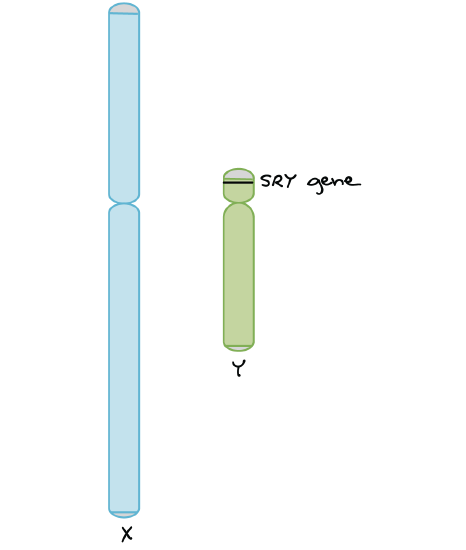
X-linked genes have distinctive inheritance patterns because they are present in different numbers in females (XX) and males (XY).
Females have two X chromosomes, so she will have two copies of each X-linked gene, giving her the opportunity to be either homozygous or heterozygous for each sex-linked gene.
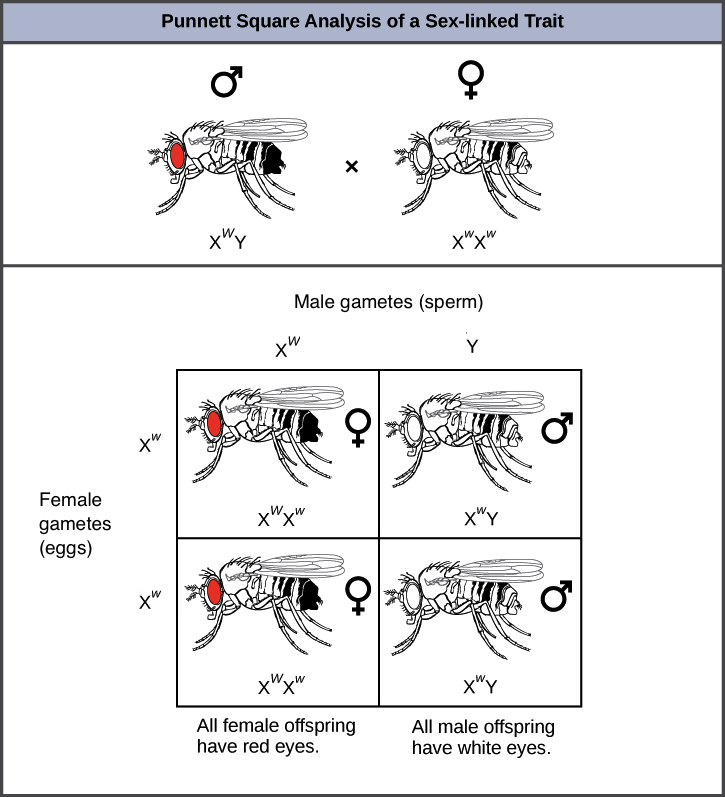
X-linked disorders
X-linked human genetic disorders are much more common in males than in females. Since males only have one X chromosome, and therefore one copy of any X-linked genes, whatever allele the male inherits for an X-linked gene will be expressed.
An example of this is the blood-clotting disorder, hemophilia. Women who are heterozygous for hemophilia are carriers, and they usually don't display any symptoms themselves.
Sons of these women have a 550, percent chance of having hemophilia. Daughters have little chance of having hemophilia (unless the father also has it), and will instead have a 550, percent chance of being carriers.
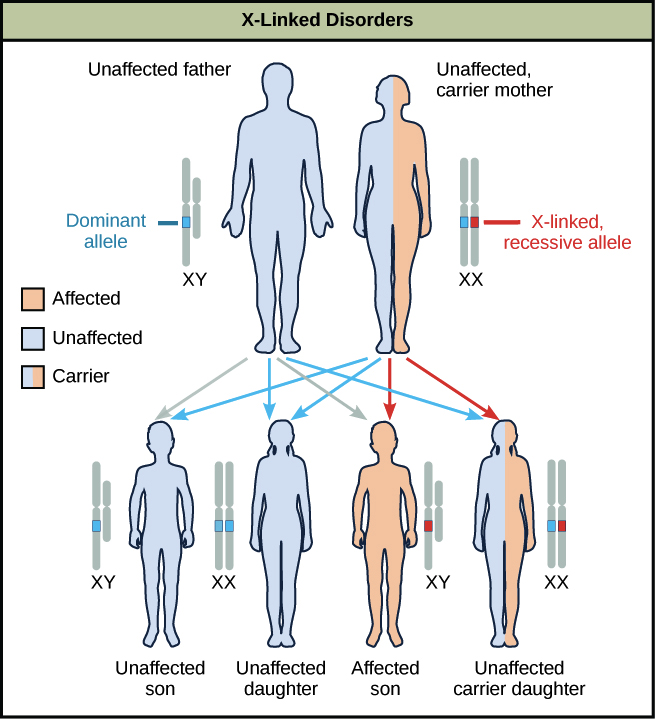
X-inactivation
If males can survive with only one X chromosome, why doesn't it cause problems for women who have two X chromosomes?
As it turns out, for females, most of the genes in one of the X chromosomes is inactivated, forming a Barr body. This inactivation happens randomly during embryonic development.
Example:
A common example of X-inactivation is seen in cats. If a female cat is heterozygous for black and tan alleles of a coat color gene found on the X, two Xs (and thus, the two alleles of the coat color gene) will be inactivated at random in different cells during development.
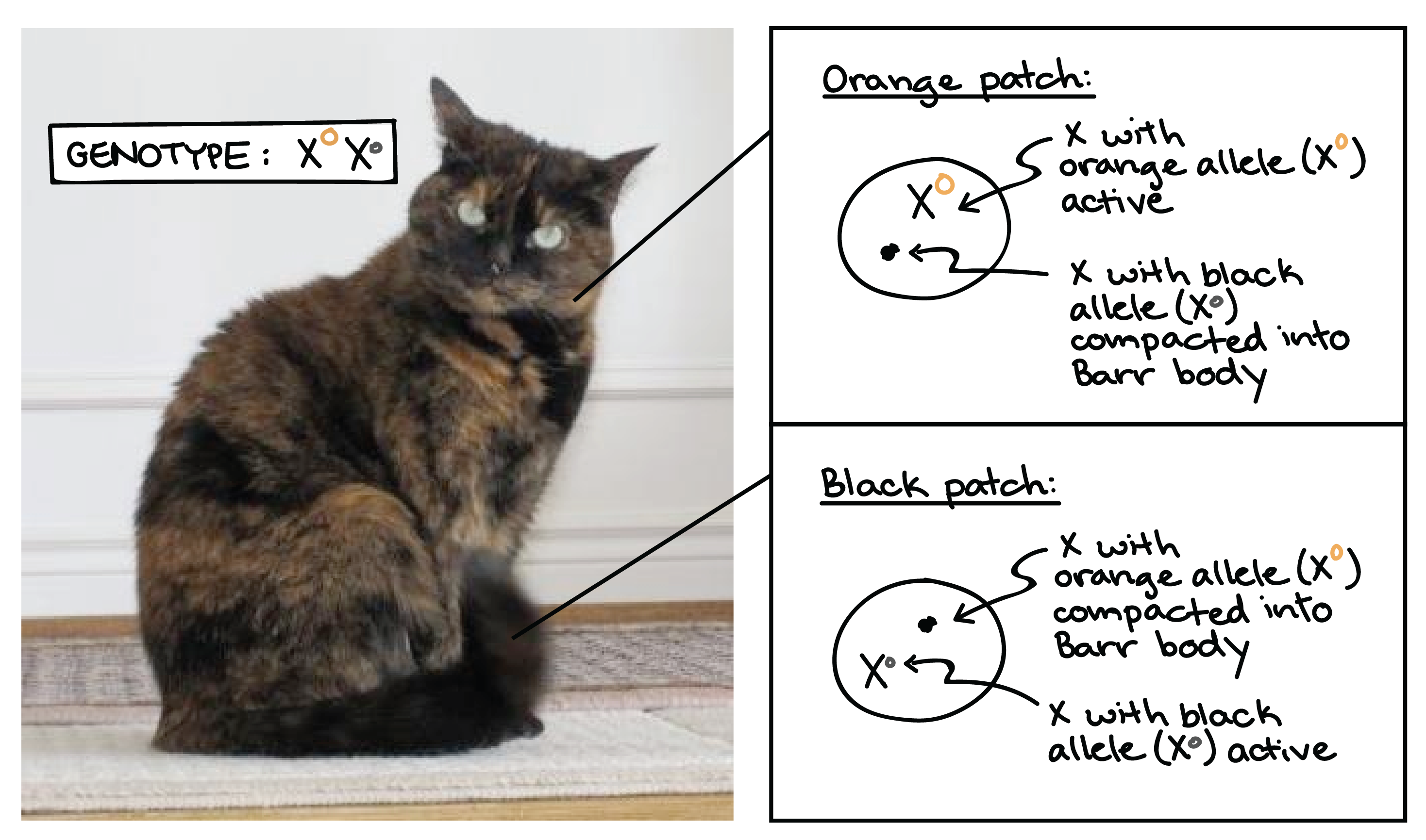
The result of this is a tortoiseshell coat pattern, made up of alternating patches of black and tan fur.
Sex chromosome aneuploidy
Aneuploidy, or disorders of chromosome number, are generally caused by nondisjunction. This occurs when pairs of homologous chromosomes or sister chromatids fail to separate during cell division.
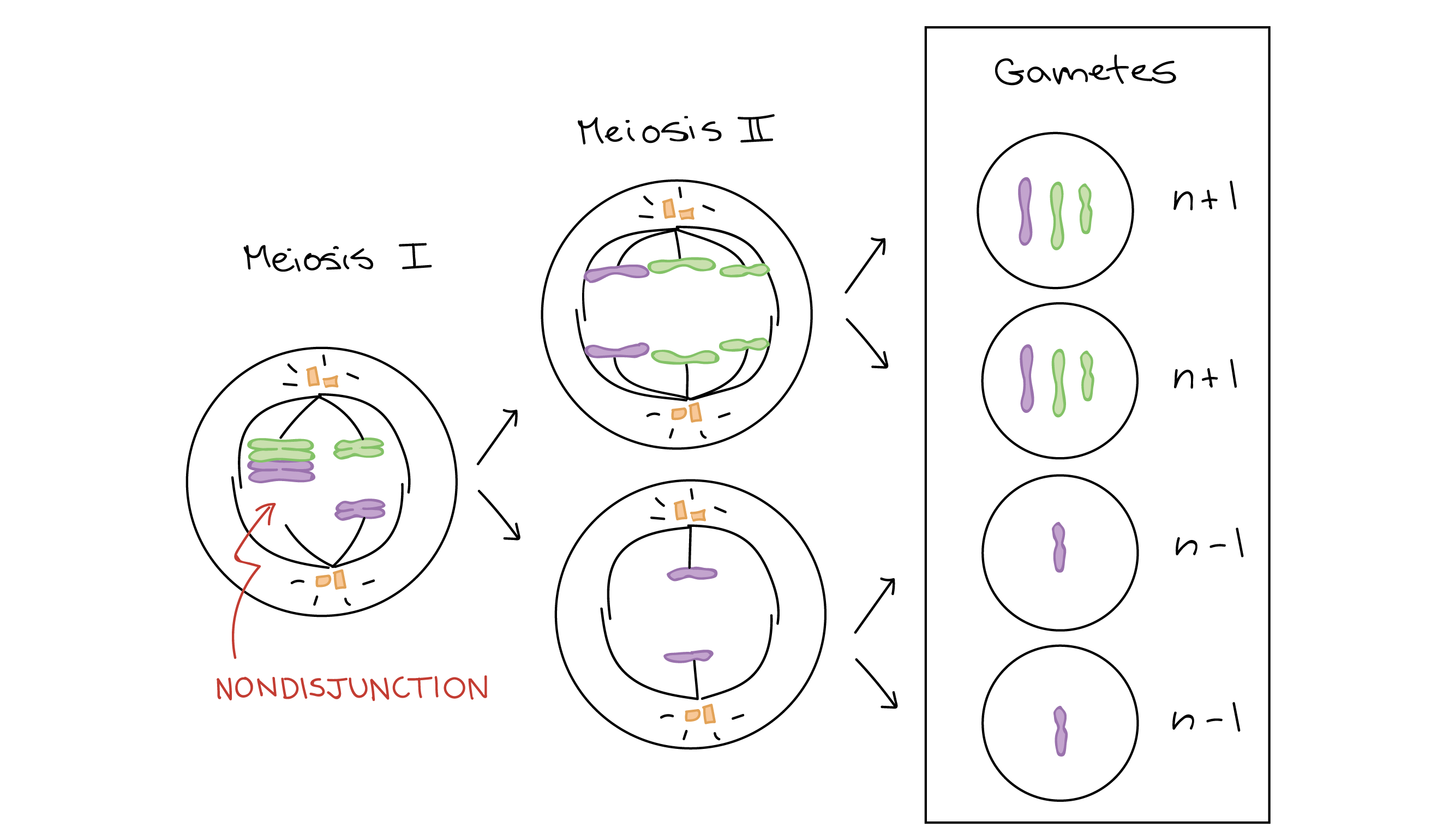
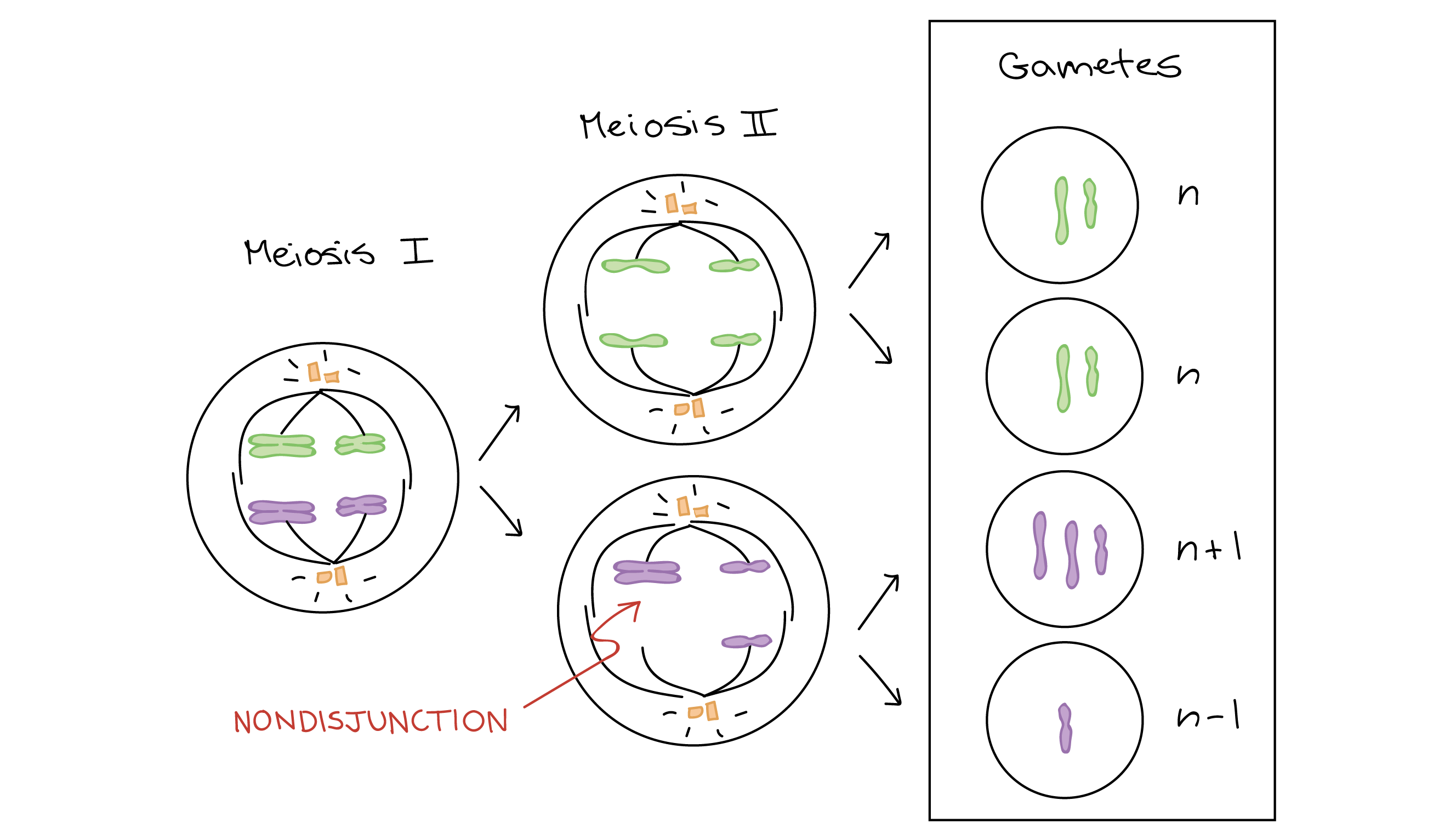
Individuals that have autosomal aneuploidy rarely survive to birth. However, due to the size of the X chromosome and because of X-inactivation, X chromosome aneuploidies tend to be much less harmful.

In Klinefelter syndrome, males have one or more extra X chromosomes, leading to a genotype of XXY. (Or in rare cases, XXXY or XXXXY!) Affected men may be infertile or develop less dense body and facial hair than other men.
Women affected with Triple X syndrome have an XXX genotype. Women with Triple X syndrome have female sex characteristics and are fertile (able to have children).
Women with Turner syndrome lack part or all of one of their X chromosomes (leaving her with just one functional X). People with this disorder develop as females, but often have short stature and may experience infertility and learning difficulties.
Common mistakes and misconceptions
-
Some people think that a recessive X-linked trait will show up more often in women because they have two X chromosomes. However, women are less likely to express recessive X-linked traits because there is potential for a "good" allele to mask a "bad" allele. On the other hand, if a male receives a "bad" allele from his mother, he has no chance of getting a "good" allele from his father (who provides a Y) to hide the bad one.
-
Codominance and X-inactivation are not the same. Although these two concepts may result in similar looking organisms, a heterozygous individual expressing a codominant trait will express both alleles fully and separately.In X-inactivation, females express only one X chromosome in each cell, meaning that genes on the X chromosome are expressed singly instead of in a pair. Because the inactivated X chromosome is not the same in every cell, neighboring cells may express different proteins if different X chromosomes carry different alleles.
Contributors and Attributions
Khan Academy (CC BY-NC-SA 3.0; All Khan Academy content is available for free at www.khanacademy.org)

